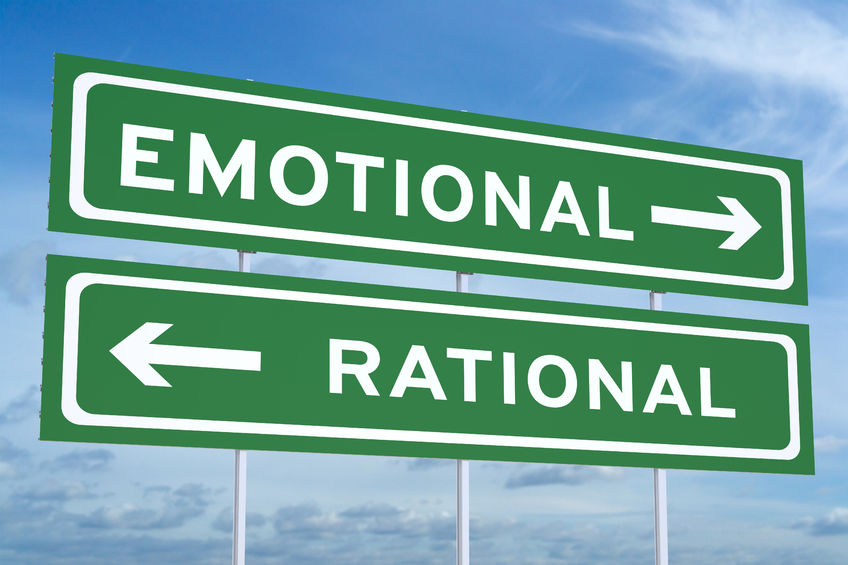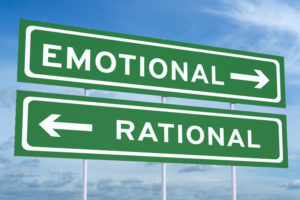The #1 Most Surprising Myth of Leadership:

You Aren’t a Rational Leader and Four Ways to Make Better Decisions

“Well, they are a business. I’m sure they’ve got good financial reasons.”
A friend and I were discussing the poor quality of service delivered by a local company. After we concluded our conversation, I reflected on his statement.
He expressed one of the mostly commonly held beliefs that we have about leaders or decision makers.
We believe that leaders are rational. That leaders make rational decisions.
It’s a myth.
It’s a common story told during the political season. It is a frequently told Hollywood tale. The heartless, calculating, objective, cold, corporate fat cats. Making decisions based off of spread sheets and objective analysis of data.
As leaders, we also tend to buy into the myth. Of course, I know it’s the other guy who is cold and calculating. But I do like to believe that my leadership decisions are well-considered, objective, data-driven.
I wish.
The Mythical Creature Called: The Rational Leader.
Antonio Demasio is a neuroscientist out of the University of Southern California. He was researching individuals who had experienced brain damage to the part of the brain that generates emotions. In most ways they acted totally normal.
They just didn’t feel emotions.
They also couldn’t make decisions.
This is a pretty big deal for professional decision makers – otherwise known as leaders.
Decisions Are Driven by Emotion.
I really came to understand this as a consultant. In executive coaching I thought I would primarily be spending time working on strategy, researching patterns for growth or addressing organizational challenges.
Instead, I spend most of my time helping leaders work through Fear. Self-doubt. Apprehension. Reluctance. Anger. Worthlessness.
Mind you, most of my clients are highly successful in their roles. From the outside, many people would envy them. They do tend to project a classic “executive” presence. The Boss. In Charge. Solver of Problems. The Steady Hand During the Storm.
And it isn’t a false front. It just isn’t the whole picture.
Learning to Relate to Emotions
I’m a certified Myers Briggs Type Indicator facilitator and instructor. This means I have some understanding of personality and personality theory. It also means I know that my “type” (INTJ) is considered to be one of the most reason trusting/emotion distrusting personalities around.
However, in practice, it often just means that I rationalize my emotions faster than others. It has also meant that I was slow to recognize and respond to the many times where I hit plateaus or walls in my professional growth.
Those plateaus or walls nearly always didn’t have to do with me not knowing enough. They nearly always had to do with me not acknowledging and knowing how to relate to my own emotions or the emotions of others.
I wanted leadership and success to function like an equation: Take Tab A and put into Slot B and get Result C. But it doesn’t work that way.
Even when that equation is accurate, it fails to account for feeling insecure about Tab A and angry about Slot B and unsure that Result C is really something I can experience.
Learning to accept my emotions and work with them has dramatically related to my ability to lead and my ability to grow my business has dramatically improved as well.
However, Emotions Are Lousy Indicators of Direction
Emotions are important. They are indicators that something in the situation is important or valuable to us. They motivate us to act. They help us push through tough times.
But if you use your heart as your compass, you’ll end up careening all over the place. (It doesn’t matter what Hollywood would like you to believe. Just watch the roller coaster of Hollywood lives, families and careers…)
So, emotions are a poor compass. But they are great fuel. (And actually, they should influence our reading of the compass.)
How to Work with Emotion to Make Better Leadership Decisions:
- Become Emotionally Literate. (Skip this if you are already here.) About a dozen years ago, someone handed me a chart. The chart was made of three concentric rings. Each ring was subdivided into sections. The middle ring had four emotions labeled in it. The second ring expanded with a more nuanced and underlying expression of those emotions. The third ring took it even further to even more nuanced and deeper roots of emotion.
It was a shock to me. At that time, I would say I either felt “Energized” or “Angry.” Those were the only two emotions I thought I had. They weren’t actually my only emotions. I mostly just didn’t know what I was feeling. So I didn’t understand many of my actions.
Taking the time (and getting help) to become more emotionally literate liberated me. I could now understand the words on the page.
- Have a Clear Picture of What Is Most Important. Many people would call this “vision and values.” Become very clear in your mind about what you are trying to create in your life, your career, your role, in a project or situation. Become very clear about your guiding values.
When you have clarity on these things – you can always refer to them as navigation points when you discover that emotion is forcing decisions. It will help you make decisions that may feel hard or difficult to commit to.
- Develop a Criteria for Decision Making: Before you make your decision or even explore options – determine what you will use to indicate that, “Yes, this is a good decision!”
You may have different criteria for certain family decisions as opposed to certain work decisions. You should treat hiring decisions differently than strategy decisions. All of which should be informed by the vision you are creating and the values you hold dear.
Just take some time, before you make a decision, and describe for yourself how you will know if your decision is a good one.
I have learned to include emotions in this criteria. Particularly for long term commitments, I pay attention to whether or not I feel a sense of peace or positive anticipation. If I don’t (even if those feelings co-exist with fear or anxiousness), then I try not to choose them.
I’m also clear on things like expected outcomes, commitment, quality, cost, etc. Developing criteria in advance of making the decision helps you make better decisions.
- Accountability in Decision Making: Leaders who have no accountability in decision making tend to make more poor decisions. Some leaders have the built in accountability of boards or teams.
Others may need to create it. I often communicate to my team when I know the additional accountability will help with decision making. I always have a coach and mentors in my life who I can bounce ideas off of. I make sure that there is space for others to examine how and why I’m making important decisions. It improves the decisions I make.
Do you tend to see yourself as more of an emotional or rational decision maker?
If emotional – how can you use the tools above to make better decisions?
If rational – how you can you improve your emotional literacy – so that you can relate to people and situations more effectively?
This is the seventh article in a series on Leadership Success Mindsets. To read any of the other articles in the series please go to:
7 Ways to Develop a Perspective of Abundance
3 Powerful Practices for an Abundant Life
5 Ways to Kick Perfectionism in the Teeth and Start Making Progress
The Best Way to Fail as A Leader (And How to Avoid It)
How to Know What You Are Worth
Are You a Voyeuristic Leader? How to Stop Watching and Get Engaged
The 3 Faces of The Insecure Leader & 6 Ways to Build Healthy Confidence
Article Categories
Popular articles

Download my free 10-page eBook:
How To Accomplish More Without Doing More:
Eight Proven Strategies To Change Your Life
Discover how to save eight hours during your workweek-even if you're too busy to even think about it. The resource every maxed out executive needs.